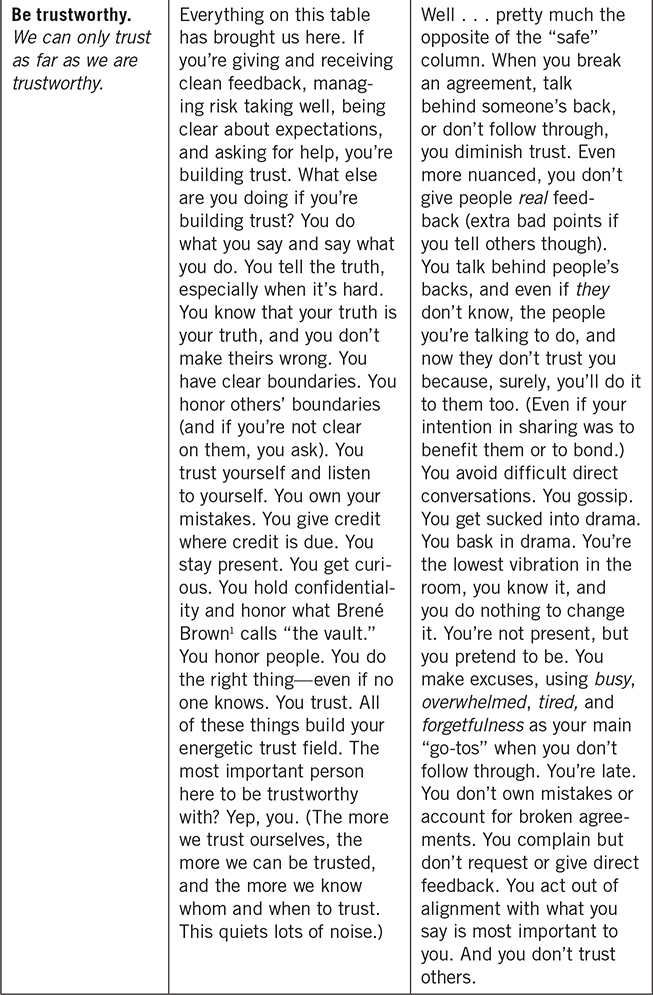CHAPTER 12
System Wellness: Navigate Conflict and Design Life-Giving Relationships. Create Them.
Conflict is inevitable; suffering is optional.
Design your systems to support you.
Let’s talk system wellness.
A “system” is any container that holds a relationship. Family, organizational and cultural, personal and professional, and team systems are at play every day and can make or break authentic connection, peace, and results. Systems are also contagious. In this chapter we’ll dive into ideas, tools, frameworks, and practices designed to support you in creating the healthiest systems possible, maintaining them once they’re created, and healing them when they break.
Of course, before you step into any of the tools offered in this chapter, you’ll want to work your own IEP and come into the system clear. The stronger and cleaner your IEP, the easier the system work becomes.
Components of System Wellness
There are seven components I’ve found helpful in creating system health. They all work together:
1. A name and definition for the system
2. A desire and decision to have a healthy system
3. Commitment for all parties to show up and do the work
4. Proactive design and agreements to support the relationship system
5. Clear roles and accountabilities
6. Safety for maintaining, expanding, and challenging the system as needed
7. Willingness and frameworks to fix the system when it breaks
#1. A Name and Definition for the System
As obvious as this may seem, it’s worth taking a moment to get clear about what the actual system is, the purpose of it, who’s part of it, and whom it impacts.
For example, your organizational team is a system. The purpose of that system is to create a container to do your best work together; to create meaning, safety, and connection; and to fulfill your collective purpose. Your system consists of the people on the immediate team. It also affects people beyond the immediate team, including your team members’ direct reports, their clients, their leadership, other departments in the organization, and possibly outside vendors or partners. We can go even further and see that your immediate team’s system also impacts the team members’ families and personal relationship systems, as they’ll bring the energy of stress or joy from this original system home with them. We could play this all the way out to see the ripple effects of the system and its contagiousness on even more people (e.g., the people your company’s products or services impact).
Once we’re clear on who’s in the system, and we all know we’re in it together, we can move to the next step.
#2 and #3. Desire and Decide. Commit, Show Up, and Do the Work.
I put #2 (a desire and decision to have a healthy system) and #3 (commitment for all parties to show up and do the work) together here because they need each other. A decision is a commitment; a commitment is a decision. Both need desire. So we’ll address them together.
What’s the quality of the system you desire? What’s important about that to you? Are you willing to do the work to have it?
To establish a durable system (and to get in front of conflict and mess later), there must be an expressed desire for a healthy system, clarity of why it’s important, and a decision to do the work, both as individuals and as a collective team. This can be as simple as naming the issue/opportunity with your team, partner, or whoever is in the system with you; declaring your desire for a healthy system; sharing your why; and committing to being fully committed to make it happen.
What does being committed look like? Ideally, this is codesigned between you and the others in the system. This conversation can be rich in itself, building trust, awareness, and authentic connection. What you’re looking for at the end of this conversation is a shared desire and commitment, clarity of what success looks like if you’re all doing (and being) it well, and agreements to support you in doing so.
What Agreements May Look Like
We commit to:
• Doing our work (managing ourselves and our IEP)
• Being responsible for the projections, impact, and energy we bring to each other
• Staying at the table when uncomfortable (and coming back if we need a minute)
• Naming discomfort and speaking up—even when we’re scared
• Asking for what we want and need
• Assuming good (and gathering positive evidence)
• Making it easy to be in relationship with
• Giving each other honest feedback in service of growth and connection
• Taking ownership and cleaning up our messes (and giving each other grace to do so as well)
• Doing all we can to help things go better
• Staying curious and finding the gifts
• Cocreating and honoring agreements to support us
• Staying awake to the needs of the system, the individuals in it, and the purpose of it
• Being willing to revisit and re-create agreements as we grow
• Being willing to intentionally complete when the system needs to change or an arc of relationship has come to a close
These are all forms of agreements we can make to support ourselves in showing up well together and getting our needs met. In Contagious Culture, I wrote an entire chapter on creating life-giving agreements and engagements. People have been shocked at how powerful (and easy) getting in front of their systems’ health with agreements and clear intentions has been for them. They’ve reported significant reductions in lost time, lost energy, ambiguity and confusion, pain, and chaos by integrating this conversation into their life. What I’ve become more deeply aware of since that book is the power of explicitly naming the desire to be a part of the system and the decision required on each person’s part to live the agreements.
The leadership skill and superpower of “decide” holds here as well: until you truly decide to be in a healthy system and do the work required, the energy and intention of making great progress will not be in full force. It doesn’t matter if we’re talking team, partnership, friendship, marriage, or devotion in a project. When someone is not fully in, it is felt by the other(s) in the system. This is contagious, exhausts individual and team resources, and hinders the energy and progress of the collective system. Most of us have experienced this, on either the giving or receiving end. Just think of a relationship where you cannot fully feel the presence, devotion, and decision of “in,” of the person in it with you. Or where you are not entirely in. Awareness is power here. This scenario is an opportunity to get clean; get curious; and name, honor, and decide what decision can be made next.
Everything is an opportunity for the next level of conversation and the next version of a clean system. Don’t avoid; head right in.
When the Decision Is a No or Not Clear
The strength of the system depends upon the congruency and purpose of the people in it. If it’s not the right system for you, it’s of service to name that, be clean about it, and codesign next steps for moving forward. It serves no one to have you in a system you don’t want to be a part of or can’t fully stand behind.
That said, in some cases it may be important that you’re a part of the system, either for professional reasons (they need you on the team for another three months) or for personal reasons (it’s family), or it’s something you don’t want to do anymore (and you want to finish that last 7 percent so it’s set up well). Here are some places to look to support you in being able to decide to stay a part of the system congruently until it is complete:
• What is important about this to me?
• What’s to gain by making this work? What’s to lose if I don’t?
• What are my alternatives?
• What opportunity am I missing with the way I’m thinking of this? How can we all win?
• What if I do decide no? What if I dismount and get out; Then what?
• Where might I want to get out of this because I’m uncomfortable?
• Where might I want to get out of this because I have conflict or am not naming a truth with someone in the system?
• Where am I just exhausted and need a “minute” or a day off?
• What’s the littlest thing I can decide upon that feels good to me?
• What core value would I honor by staying with this for now?
• What if I decide to decide not to decide right now and simply pause?
You don’t have to force a decision. Sometimes part of creating a healthy relationship system requires you to ask new questions, decide on a time-out, break the relationship, or do nothing (but do nothing consciously). These decisions all shift energy, giving us a new reality, new choices, and new places to step into with further information. Sometimes our most challenging relationships and situations, which we may work on for years and years—contorting, pushing, and grappling—only get healthy when we decide to tell the hard truth, walk away for a bit, or let them go altogether.
#4. Proactive Design and Agreements to Support the Relationship System
You’ve named the system and decided to be in it; you’re here. Let’s proactively design it. I have a tool for codesigning agreements and partnerships. The intention of this tool is to get in front of your relationships with clear questions and honest dialogue to support you both. I use these questions and structures with new team members, with vendors, and even in my personal relationships. Here are some core talking points and questions you can ask each other either one-to-one or with your whole team. Choose one or all as they serve.
IEP Relationship Design Model Questions
Here are 10 conversation starters, talking points, and questions to help you design your relationships proactively. (Note: It’s never too early or late to do this exercise.)
• What I appreciate and admire about you is _______________. What I’m most excited about in working with you is _______________.
• My ultimate dream for this relationship/partnership is _______________. What’s yours?
• My concerns (or what I see might get in the way, if applicable) are _______________. What are yours?
• I’m wonderful to work with in this way: _______________. I’m difficult in this way: _______________. (Be honest!)
• My intentions for this relationship are _______________.
• I need _______________ to be most successful in this collaboration. Here are some specific requests. (Great place to share pet peeves and quirks too!)
• What do you need from me? (Requests? Peeves? Quirks?)
• What agreements do we want in place to have a healthy relationship?
• How will we handle conflict or misunderstandings?
• How will we give each other feedback?
Designing for Messy
It’s going to get messy. Any good relationship system will. The mess is where you create intimacy and realness. So be ready for the mess, celebrate it, and have a plan so that when you’re in the mess, you have a rope.
This can be handled in the codesign of your relationship from the start in the previous section. Anytime in a relationship is a fine time for a new design—whether you’ve been married 20 years, worked with your business partner for 8, or had your friendship for 2.
It might look like this:
Hey, our relationship means a lot to me. I want us to be able to be honest and real and amazing together. To do this, it may get messy. We may disagree, we may fight . . . and I want that to be OK. Before we get to that point, can we design for messy? Can we put agreements in place to support us both in showing up honestly, coming back to the table, and feeling safe when we hit the ick?
No one is going to say “no” to that (if the person does, he or she may not be your person).
And then you design.
Here’s what I’d put in that design:
• How do we want to handle conflict? (Name the tension; get curious about it; check ourselves before we wreck ourselves.)
• Do we want to have a code word for when we’re upset or something feels off? (“Marshmallow!”)
• Can we have an agreement that we can “name it” without getting it right or judging it? (Yes, please. If we do our IEP work and stay in our space, this will be easier.)
• Do we both agree to come back to, and stay at, the table until we resolve it? (Knowing that taking a “time-out” is OK—we just need to let the other know we’re taking it.)
• What is the thing that is bigger than we are that we will always be in service of no matter what? (This is an anchor and could be “in service of our kids,” “in service of the health of the team/company,” “in service of our lasting partnership,” “in service of our shared vision,” etc.)
#5. Clear Roles and Accountabilities
Setting up clear roles and accountabilities is magic sauce for system health. This is beautifully done proactively, and sometimes you don’t know until you know—so anytime is a good time to engage this component.
Yours, Mine, Ours
In creating a system, maintaining it, or even fixing it, there are conversations and explorations that will support enhanced perspectives, points of view, and reframes; clarify feelings; and create shared accountability—all at the same time.
The Yours, Mine, Ours Framework provides a structure for having honest conversations to clarify roles and accountability in creating the healthiest system possible.
Determining Accountability and Clarifying Roles Up Front
Yours: What are you responsible for?
Mine: What am I responsible for?
Ours: What are we both responsible for (and who owns what in that)?
Exploring Individual and Shared Dreams and Tender Agendas
Yours: What is your dream for this? Your greatest fear?
Mine: What is my dream for this? My greatest fear?
Ours: When we’re looking at our ultimate impact, what’s our dream together? Our greatest fear?
Clarifying Emotions and Deepening Understanding and Empathy
Yours: What are your feelings about this?
Mine: What are my feelings about this?
Ours: When we’re in service of the ultimate outcome we want to create and whom we’re serving, what are our feelings about this?
Owning Accountability and Finding a Way Forward
Yours: What issue have you created here?
Mine: What issue have I created here?
Ours: What issue have we created together? What are our next steps to making it right?
Proactively Nourishing and Serving the Relationship
Yours: What will you do to make sure the relationship works?
Mine: What will I do to make sure the relationship works?
Ours: What will we do together to make sure the relationship is nourished and works?
All of these questions and frameworks are valuable launch points for these conversations. Used as they authentically resonate, any of these questions can clear relational clutter, clean up energetic hygiene, and create a higher-quality container for your system to thrive.
Note: More on role accountability, three types of reciprocity, and the Super 7 of Cultural Health in Contagious Culture.
#6. Safety for Maintaining, Expanding, and Challenging the System as Needed
One of the most significant agreements you can create in a system is making it safe to relate to each other and speak honestly.
Do you make it safe? How? Everything I’ve shared in this book has been in some way related to making it safe to show up, to being positively contagious, and to bringing our best independently and collectively. Besides having positive intent and solid IEP, there are seven areas I see as both some of the greatest sticking points and also some of the greatest places of opportunity we can home in on to create safety in systems (or not):
• Receiving feedback
• Giving feedback
• Taking and supporting risks
• Being clear on expectations
• Being trustworthy
• Trusting
• Asking for help
To support you in exploring this, I’ve created a table of some of the most common wins and fails in each of these areas. If you adopt any on the left side of the table, you’ll find that the others are affected as well.
RELATIONAL SYSTEM SAFETY
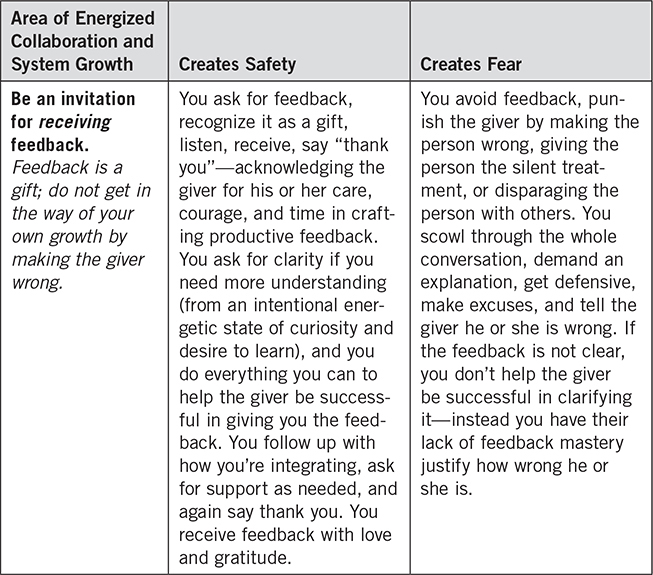
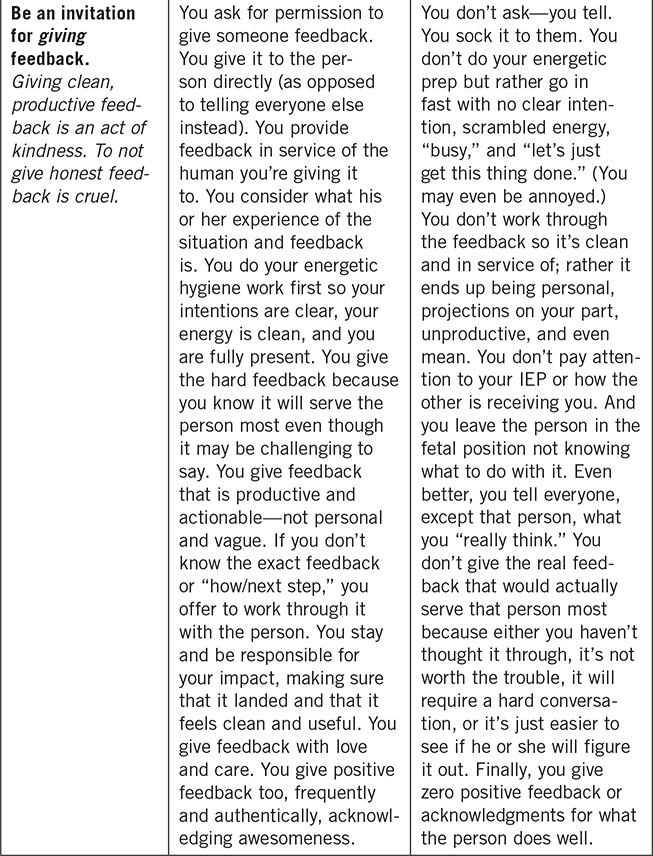
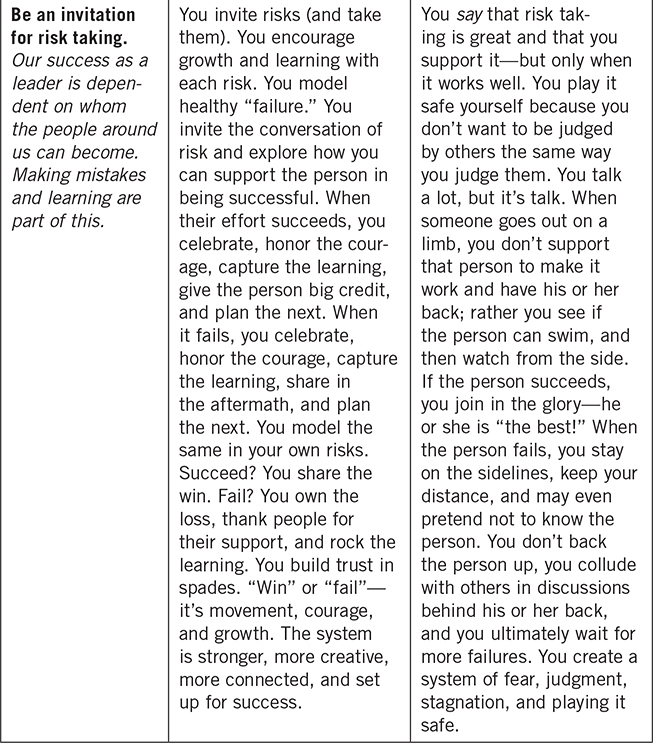

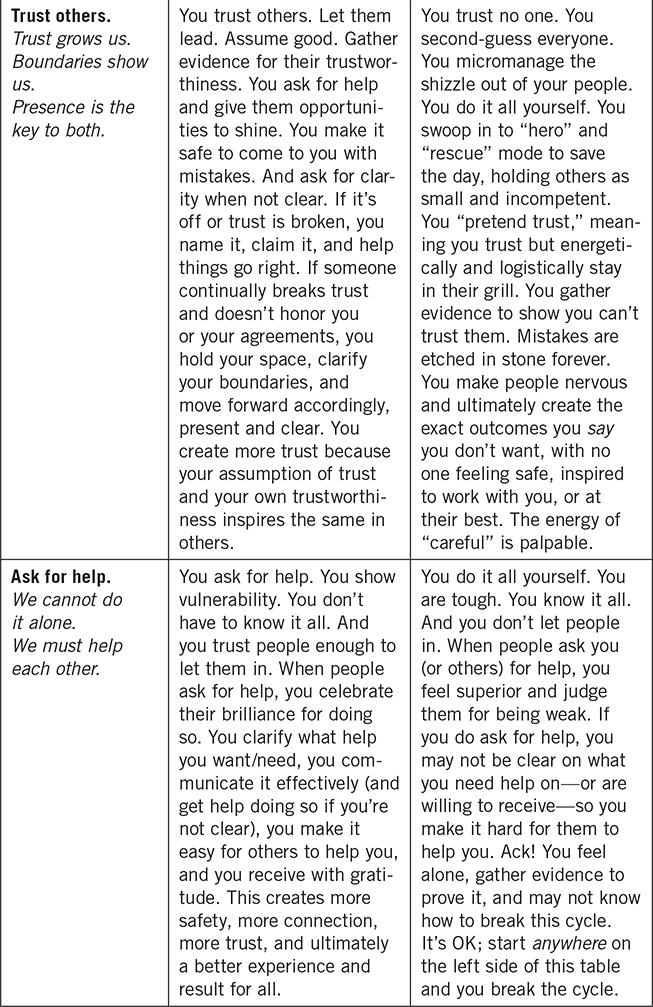
Maintenance and Healing
Once you’ve created the container for a healthy system, it becomes about maintaining it and then healing it when things break. Maintenance is as simple as regular check-ins, ongoing feedback, open dialogue, culture checks, using any of the assessments in Chapter 2 or questions in the fieldwork sections of this book.
Ask for what you want, celebrate the good, and let messy be OK. You are always growing.
Inevitably you will hit conflict. Any healthy system does.
#7. Willingness and Frameworks to Fix the System When It “Breaks”
The system is broken; there’s been a breach; it’s falling apart. Now what?
Use it, learn from it, fix it, and make it better. This is all so much easier with the first part of this book under your wing.
Ready?
Clarifying Conflict: The IEP Conflict Navigation Model
When I work with people in conflict, whether it’s two people or a whole team, it’s always interesting to see how often they’re not clear on what the actual conflict is. This is so common that I use an exercise called “The Purple Pen” to help people see how far off they may be in what their different perspectives on the problem are—or if there is even conflict. More often than not, the “purple pen” is not purple; it’s “green” or “blue”—and this opens up a whole new area of wisdom for the people, the project, and the system.
Conflict is human. It can also be scary—sometimes so scary we forget to clarify what it is.
In Parts 1 and 2 of this book, I gave you tools to stay present, stand strong, and stay clear in yourself to hold your space. In Chapter 7, I shared IEP superpowers with you, and in Chapter 9 I shared the Energetic Xylophone and turning “bad” things into “good.” In Chapter 10, we went all in on George, loved our nemesis, and learned other tools and frameworks for navigating the tricky stuff. Then in Chapter 11 we looked at OPPPE, and, now, in this chapter we’ve created a healthy system and explored ways to grow it. Here we’ll put everything together and end with a framework for navigating conflict.
Conflict? Or so you think? Let’s see.
The IEP Conflict Navigation Model
There are two parts to conflict navigation: the individual work each person must do and explore (part 1 below) and then the collaborative work you’ll do together (part 2). It’s important that the individual work is done first, independently. This can help each person own his or her own space, lay the foundation, set the tone, and create more clarity and ease for the collaborative work together. Sometimes, after doing part 1, part 2 becomes unnecessary. See what’s true for you.
Part 1: Individual Work
1. Identify the conflict? What is it? (Name it.)
2. Who is it with? (Beware the “they.”)
3. Is this issue “worthy” of conflict? (Or can you find another perspective, and/or let it go?) Yes, conflict worthy? Continue . . .
Check yourself before you wreck yourself:
1. How’s your IEP? Is it in service of, or not?
2. What’s your regard for the other people?
3. What assumptions are you making?
4. What might their experience of you be?
5. What truth are you not speaking?
6. Where are you in defense—proving it or attached to being right?
7. What’s your request?
8. Is there a boundary breached or a new boundary that needs creating?
9. Are you “assuming good”? Curious?
10. Have you truly “decided” to resolve this/have a good relationship/etc.? How might this be “serving” you?
Once you’ve done your own work and you’re clean, if there is still conflict, ask your person/team (whom you have “conflict” with) to get together, get curious, and explore the talking points in part 2. (Note: If you are really stuck here, or the situation is extra charged, it may be useful to do the “Love Your Nemesis” exercise I offer in Chapter 10.)
Part 2: Collaborative Work
With part 1 complete, if you’ve found there is still conflict and tension, it’s time to move to part 2. Get your IEP clean and right, and then together, you’ll explore the following . . .
1. Name (with curiosity and care) that there is conflict or misalignment. (“I’m noticing something feels ‘off’ here. Do you feel it?”)
2. Create a statement of intent (“I want to resolve this because I care about our relationship/I want you to succeed/I want our team to rock it.”)
3. Agree on what’s bigger than both of you; what is this conflict navigation in service of? What is the ultimate thing you are serving? (“We are in service of our kids, this team, our client, our employees, or this invention that will cure cancer . . .”)
4. Name what you believe the conflict or misalignment is. Does the other person agree? What’s the other person’s experience? (“I sense it’s this _______________. /I’m making up that it’s this _______________. What is your experience?”)
5. Get curious together and listen. Hear each other out.
6. Ask for support from an unbiased party if needed to help work through the issue. (Do not preload the person with details on either side; keep it clean.)
7. Work it back and forth, keeping the bigger thing you are both in service of as the third entity you are creating alignment around. Keep breathing and staying present.
8. Create new agreements, including next steps, any communication needed, and new ways of working or being together.
9. Apologize, own, honor, commit, champion, and acknowledge each other for coming to the table to work this out.
10. Revisit the first exercises in this chapter to now up-level your new relationship and design for the future.
Now that you’ve got you handled, your presence humming, and your relationships zooming, let’s move to Part 4 as we step into leadership, bringing people with us, accelerating team magic, and growing more positively contagious leaders.
Fieldwork: Make It Real
Let’s get to work and make your relationships more pleasurable and life-giving! I’ve addressed seven components of system wellness in this chapter. You may have found that these apply to all kinds of relationships (personal, professional, private, team, etc.). Here are four things you can do now to address any and all of your systems, up-level your leadership in them, and create more positively contagious outcomes:
1. Address anything that “pulled” (or “pushed”) you as you read this chapter. Unclear about your system? Name and define it. Need agreements as a team? Create them. Not clear on a decision? Dig in. Roles and accountabilities tripping you up? Engage. Use the structures, questions, and exercises in each section to support you here. And then go deeper . . .
2. Choose three relationships you want to up-level and do the exercises offered in component #4 (the IEP Relationship Design Model Questions and the Designing for Messy exercise).
3. Review the Relational System Safety table. How are you doing? Give yourself an honest assessment on both sides of the grid in all seven areas. Choose one area this week to improve. Next week, choose another.
4. Choose one relationship you have conflict with and work your way through the IEP Conflict Navigation Model Questions offered in component #7.

